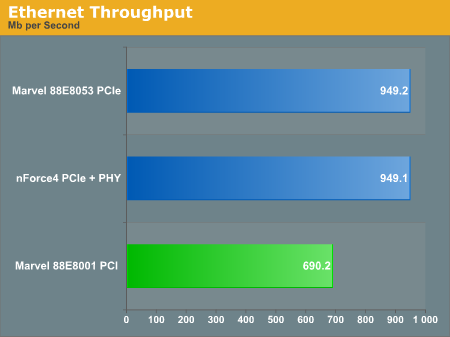nForce4 Ultra Roundup: Charting the Mainstream
by Wesley Fink on July 5, 2005 10:28 PM EST- Posted in
- Motherboards
Ethernet Performance
We have often talked about the throughput advantage of PCI Express compared to PCI and its impact on Gigabit LAN performance. To show you this, the new motherboard test suite includes LAN performance measurements.The Windows 2000 Driver Development Kit (DDK) includes a useful LAN testing utility called NTttcp. We used the NTttcp tool to test Ethernet throughput and the CPU utilization of the various Ethernet Controllers used on the nForce4 Ultra motherboards.
We set up one machine as the server; in this case, an Intel box with an Intel CSA Gigabit LAN connection. Intel CSA has a reputation for providing fast throughput and this seemed a reasonable choice to serve our Gigabit LAN clients. At the server side, we used the following Command Line as suggested by the VIA whitepaper on LAN testing:
Nttcps - m 4,0,On the client side (the motherboard under test), we used the following Command Line:-a 4 - l 256000 - n 30000
Nttcpr - m 4,0,At the conclusion of the test, we captured the throughput and CPU utilization figures from the client screen.-a 4 - l 256000 - n 30000


All Ethernet tests were performed with standard frames, but Gigabit Ethernet supports Jumbo frames as well. Jumbo frames will theoretically provide a further reduction in CPU overhead. We have seen test results that show the combination of Active Armor and Jumbo Frames can reduce CPU utilization below 10%, which is very respectable performance for on-chip gigabit LAN.










75 Comments
View All Comments
yacoub - Wednesday, July 6, 2005 - link
#33 - Wesley, that's awesome news. Can you post that somewhere more important so buyers know to be on the lookout for it? =)kyparrish - Wednesday, July 6, 2005 - link
Good article!I'm seriously considering dumping my DFI S754/NC 3200+ setup for that Epox board and a cheap S939 A64 :)
Wesley Fink - Wednesday, July 6, 2005 - link
#29 and #31 - UPDATE: I have talked with contacts in the Memory Industry and Samsung TCCD is now available again from Samsung. TCCD disappeared for a few months but production didn't really stop. TCC5 is DDR466 and TCCD is DDR500, but both chips come off the same line and are binned for speed grade. Samsung stopped binning for DDR500 grade until recently - and left this job to the memory makers.Recently Samsung has told memory makers they are binning once again for DDR500/TCCD and the TCCD chips are available again. It will take a few weeks for the pipelines to fill but TCCD is not dead. Some companies are staying with TCC5 at a lower cost and binning for the top performance unless the yields start to go down.
Wesley Fink - Wednesday, July 6, 2005 - link
#24 - The base nForce4 is sometimes called the nForce4 X4 and runs at 800 HTT, while the Ultra and SLI run at 1000HT. When 1000HT was first introduced we found no real difference in performance at 800HT and 1000HT. What the 1000HT did provide was quite a bit more overclocking headroom. A reader may have an example of where 1000HT outperforms 800HT but the real world difference is negligible.#28 - There are now more than 60 BIOS releases for the DFI nF4, many customized for particular memory types. Only 3 have been posted to their website. For the latest DFI nF4 BIOS a good place to check is www.xtremesystems.org or the BIOS Files Forum at www.bleedinedge.com. There is now a 7/04 BIOS that is reported to be more stable in upper memory ratios (433,466,500) with Rev. E chips.
#29 - You are overstating the TCCD situation. Corsair still sells TCCD, as do several other memory vendors. There is no doubt TCCD is drying up everywhere but Corsair, and that will continue. New TCC5 dimms that are said to perform like TCCD are in process in at least one memory company. We have requested these new TCC5-based dimms and will share our findings as soon as we receive the memory. There are also some new BH5 dimms that we thought were gone forever. We have even seen the new BH5 binned and advertised as DDR500 2-2-2 at higher voltages around 3.3V.
yacoub - Wednesday, July 6, 2005 - link
Well, while this review -has- convinced me to go with the DFI board over the Chaintech, that is purely due to the audio CPU usage issues of the onboard vs daughterboard. I'm shocked at how much difference that makes.That said, most of the memory testing (and thus most of the review) was meaningless to me (and everyone else who doesn't have access to TCCD memory anymore). =/
Wesley Fink - Wednesday, July 6, 2005 - link
#17 - Thanks for pointing out the errors. They have been corrected. Do you want a job proof reading :-)yacoub - Wednesday, July 6, 2005 - link
Regarding the tRAS recommendation:Can we petition Anandtech to stop using memory that the consumer can't get anymore? (Namely TCCD-based Plat Rev2.) Go pick up some TCC5 and do your tests with what the consumer is actually going to be receiving so your tests actually mean something.
mongoosesRawesome - Wednesday, July 6, 2005 - link
What BIOS version did you use with the DFI? It reads: "Award 7/01/2005 Release" in your list of features for the DFI, but I could not find that BIOS release on their website.AsiLuc - Wednesday, July 6, 2005 - link
Sorry I meant: GA-K8NF9http://www.giga-byte.com/MotherBoard/Products/Prod...
AsiLuc - Wednesday, July 6, 2005 - link
I'd liked to see the Gigabyte GA-K8NP9 reviewed, because it has passive southbridge cooling (silence :) ) and is cheap.